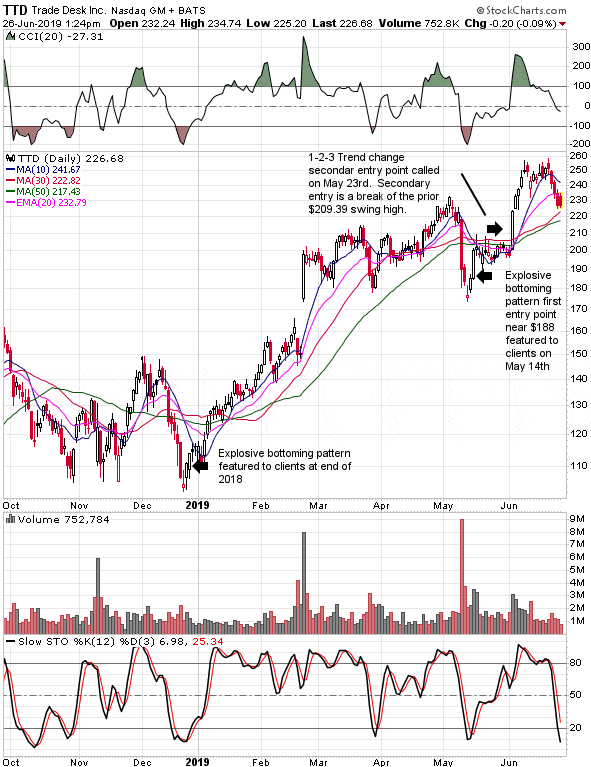Swing Trade Stocks – Secondary Entry Stategies
One of the more frustrating events when swing trading is when you see a great stock reach a good entry point and take off without you. If you do not have a good routine of consistently screening for good trading candidates each day, you often miss the best ones.
Fortunately, great stocks often offer traders a good secondary entry point after a large first wave higher.
For most trades, I want to just enter at the initial technical entry point. Most trades just do not show signs of having home run potential early on.
However, if the stock gets off to a great start, a good secondary entry point will often develop in the days ahead. If the technical and fundamental factors both display home run potential, I look for a good follow-up entry when swing trading.
Entry Strategies for a Swing Trade after Missing a Big Move
This first example is TTD which has appeared in our Daily Alert several times this year. The stock broke out of our explosive bottoming pattern after we featured it to clients to kick off the new year and the stock actually set up the pattern again in May.
In May, TTD reached our technical entry point and then surged nearly 10% within 24 hours after being featured to subscribers. A very good start.
But what if you missed the initial move and technical entry point?
Well, one thing to note about this trade is that the stock pulled back sharply within a multi-year uptrend before setting up the explosive bottoming pattern. Also, earnings and sales have been growing in the mid to high double digits per year. Its also one of the top young growth stocks in the market less affected by trade and political risk.
All of these factors help to give it the home run potential. As long as it gets off to a strong start, we are very interested in a good secondary entry point.
Here is a good secondary entry strategy on a stock that is acting strongly after jumping out of a bullish reversal pattern.
Once we see an initial strong move higher after a large pullback, we want to look for what we call a “1-2-3” trend change for the secondary entry point. Other less common bullish patterns include the rounding bottom and double bottom pattern.
A 1-2-3 trend change is a higher swing low followed by a break above the prior swing high. Some suggest looking for this from day to day as a swing trade entry strategy for stocks and I wanted to point that out.
However, we found it more effect to wait for a new multi-day downtrend to develop and turn around to form the higher low after the longer pullback. The larger the pattern, the bigger potential the trade generally has on the best stocks.
For subscribers, we watched for the 1-2-3 trend change on a daily chart. Once the pattern was developing, we said to look for a move above $210 for a good secondary entry point. Here is a chart showing both entry points.

We want to see the prior low really tested with another multi-day downtrend rather than a higher daily candle low the next day. We want to first see a strong initial rally, then another real pullback to develop before forming a higher swing low on a longer time-frame. In our opinion, this is key.
The entry point is a move above the prior swing high. So it needs to confirm a higher low during a pullback and then rally to exceed the prior high or we could even wait to see if it closes above it for further confirmation. This confirms the trend change back to the upside.
To play the initial bounce, we want to see exceptional technical strength just prior to the entry point. In other words, an oversold condition followed by a big rebound already developing and then confirmed the next day.
The levels of resistance above the entry point are key things to analyze as we do in our explosive bottoming strategy.
Once TTD hit the secondary entry point (the 1-2-3 trend change), it took off and gained another 20%+ within a week.
So, as far as we are concerned, all is not lost if you missed the original ideal technical entry point. As long as the stock has the fundamental and technical factors that give it a stronger chance of being a home run trade.
In the next post we will look at another good secondary entry point we use on the biggest opportunities the market offers. Another home run winner we featured to clients over the past few weeks.
Secondary Entry Points – Part 2
Swing Trading Opportunities on Top Stocks We are Eyeing for Our Own Accounts this week







